 Japan Maritime Self-Defense Force:
Japan Maritime Self-Defense Force:ASW destroyer (1957-90): JDS Ayanami, Isonami, Uranami, Shikinami, Takanami, Oonami, Makinami
JMSDF Destroyers
Harukaze | Ayanami | Murasame | Akizuki | Amatukaze | Yamagumo | Takatsuki | Minegumo | Haruna | Tachikaze | Shirane | Hatsuyuki | Hatakaze | AsigiriThe Ayanami class were follow-up of the Harukaze, the first class of large warship designed and built in Japan in 1956-60 under the new JMSDF, for ASW warfare. These were unofficially designated DDKs, considered as escort destroyers, but had the size of fully grown destroyers. Four ships were built under the 1955 programme, one under the 1957, two under the 1958 programmes. They were vastly different from their predecessros in many ways, no longer “fletcher-like” but now sporting Twin US 76mm DP guns Mk 33s with Japanese shields, and later a bulwark aft of the hull break. Reload for main torpedoes were back in deck racks, standard practice on WW2 Japanese destroyers. These were also the first Japanese destroyers with full NBC protection, having eight wash-down systems to remove radio-active fallout. They were modernized in the 1960s and 1870s, kept in service until the late 1980s, the last two stricken in early 1990, shortly befotre the end of the cold war.
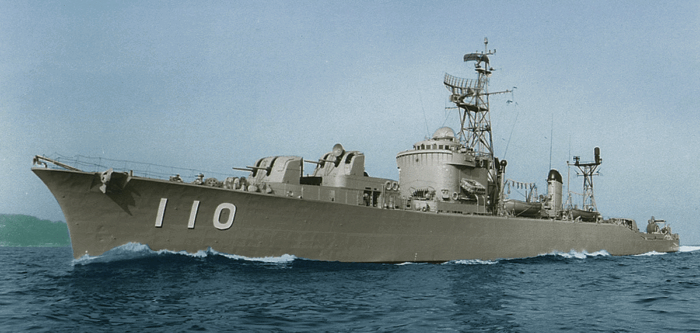
Development of the Ayanami class
Genesis, F-102 Plan
 Their origin is found in the Guard Corps Harukaze class as part of the 1953 plan, resuming domestic construction of destroyers. In order to prioritize numerical increase to front-line forces, extremely deficient at the time, the 1954 plan focused on the construction of small vessels such as submarine chasers, no large patrol ships. But construction of large ships was resumed again in 1955, after the establishment of the Maritime Self-Defense Force. First, in the 1955 plan, it was decided to build a destroyer with an enlarged hull up to 1,700 tons, reflecting the knowledge gained through planning, design, and construction of the Harukaze class. This was a major redesign, compromising on artillery armament, but enhancing anti-submarine warfare capabilities, thus unofficially referred to as an anti-submarine escort ship (DDK/DDE) for budgetary reasons when requested at the diet for explanations.
Their origin is found in the Guard Corps Harukaze class as part of the 1953 plan, resuming domestic construction of destroyers. In order to prioritize numerical increase to front-line forces, extremely deficient at the time, the 1954 plan focused on the construction of small vessels such as submarine chasers, no large patrol ships. But construction of large ships was resumed again in 1955, after the establishment of the Maritime Self-Defense Force. First, in the 1955 plan, it was decided to build a destroyer with an enlarged hull up to 1,700 tons, reflecting the knowledge gained through planning, design, and construction of the Harukaze class. This was a major redesign, compromising on artillery armament, but enhancing anti-submarine warfare capabilities, thus unofficially referred to as an anti-submarine escort ship (DDK/DDE) for budgetary reasons when requested at the diet for explanations.
As with the preceding ships, the basic design was outsourced to the Ship Design Association, with a basic plan number being F-102.
The Ayanami class were destroyer built for the Japan Maritime Self-Defense Force (JMSDF), designed in 1952-52 as an alternative to the Harukaze, with more emphasis on AA escort capabilities, while ASW remained their main role. This primary purpose, anti-submarine warfare, had them classified as “DDK” or hunter-killer anti-submarine destroyer, but this remained unofficial and they kept their DD classification. This was the beginning of the so-called “Dutch Saka” type escort ship, with seven ships were built around the time of the first defense force improvement plan in 1955-1958, as anti-submarine escort ships (DDK/DDE) with reduced artillery. Construction cost was 2.55 billion yen per ship. They were retired from the mid-1980s, and ceased operation by 1990.
Design Differences

JDS Ayanami in the 1970s
There were many differences from the initial Harukaze, trailblazers for the Japanese shipbuilding industry to return to warship design. They looked like a more confidently Japanese design, and for the first time they adopted a long forecastle design and a very peculiar inclined afterdeck, called “Holland Slope”, after the scenic sloping street in Nagasaki City. This type of sloped deck was common in Japanese construction, notably cruisers in the interwar, despite their flush deck hull. They were also designed with a steam turbine propulsion system similar to the ones used on the Harukaze class, but varied between ship batches for comparative tests and see what the best fit for future destroyer construction. This was closer to the US doctrine. This as part of the JMSDF’s drive towards excellence for its future surface combatants, expecting more classes to be built in the future.
The Ayanami class were still equipped with US weaponry and sensors, but the US already desrired the Japanese Industry to gear up and provide some of the hardware used by the US Army in the cold war already, and this only grew later in the Vietnam era. The Ayanami became the first JMSDF vessels equipped with the US 3-inch/50 caliber Mark 22 guns, with Mark 33 dual mounts, but Japanese shield-turrets. They were also controlled by two Mark 63 GFCSs. They were also the first fitted with the new Mark 32 lightweight acoustic torpedoes, having two Mark 2 over-the-side launchers while keeping a quadruple bank of 533 m torpedoes for anti-ship work. Their main weapon remained a pair of edgehogs, even so this armament was now seen as obsolete in the 1960s.
All seven were named after World War II-era Fubuki and Yūgumo-class destroyer classes sunk in action.
Authorized by the diet on 1955 they were founded and planned to be laid down on six yards FY1956, FY1957 and FY1958. The yards concered were:
DD103 Ayanami (あやなみ)(ASU7004 1983): Mitsubishi Zosen, Nagasaki.
DD104 Isonami (いそなみ) (1983 TV3502): Shin-Mitsubishi, Kobe
DD105 Uranami (うらなみ) (1983 ASU7005): Kawasaki, Tokyo
DD106 Shikinami (しきなみ)(1983 TV3503), DD110 Takanami (1985 ASU7009): Mitsui Zosen, Tamano
DD111 Oonami (おおなみ) (1987 ASU7013): Ishikawajima HI, Kobe
DD112 Makinami (まきなみ) (1987 ASU7014): Iono HI, Maizuru
Foir the first time, legacy yards such as Kawasaki, Maizuru, Ishikawajima were invited to participate in the effort, becoming their largest warships postwar, while Mitsui Zosen, Tamano was not a brand new yard (it was founded in 1917), but this was their first important warship order. Mitsui Engineering & Shipbuilding were indeed known in the interwar as Tama Shipyard. They had been famous in 1924 for building the first Japan-built diesel-propelled merchant ship, Akagisan Maru. They were mostly known for light, samll warships, such as gunboats (Atami, Kotaka), modern tprpedo boats and escorts in small numbers, as well as minesweepers and submarine chasers. For this, they were selected to built also the JMSDF W-7 minesweeper, and in the 1980s, the Abukuma class destroyer escorts, a Hiuchi class support ship and more recently two Ōsumi class LSTs.
Design of the class
The previous 28DD design was designed to fill a technological gap of nearly 10 years postwar, based on the technology of the Imperial Japanese Navy mixed with new US Navy elements for weapony and sensors compatibility. However, seeing how this design (Harukaze class) worked out, the Japanese thought the flush-deck hull design was problematic due to a lack of space, reducing habitability, with lacking room for future expansion of electronics or armament. So in designing this new type, the Ship Design Association created a proposal featuring a uniquely long forecastle design, which was advantageous for securing extra space on board, in addition to a flat-deck hull design of the 28DD. The only examples overseas at the same time were the Royal Navy’s Whitby-class frigates and Canadian Navy’s St. Laurent-class destroyers, both for coping with heavy weather better, so the military, initially reluctant, was ultimately convinced by the Association because of its many advantages.
The long forecastle hull type, needed extra strength between the forward and rear steps, usually a break, and so a a weak point. On this design, the joint used a continuous sloping deck at about 13 degrees. After commissioning, this sloped deck was called “Dutch slope” by the crew. But it was unpopular due the awkwards spaced created inside and slippery nature in heavy weather. However overall this was considered a good design, also adopted by the next Murasame and Akizuki classes. The forecastle was long and took three-quarters of the forward hull, leading to an increase in reserve buoyancy and also improving survivability in case of a hull damage.
The adoption of this hull type reduced the wind pressure side area and improved stability. In addition, the tall upper deck was lowered to the required height for the engine room, eliminating dead space above the engine room ceiling, with an overall side height reduced by about half between decks compared to the previous flat deck type. The cross-section was increased, by making the forecastle deck into a reinforced deck, with longitudinal strength using lightened structures, increasing overall the ship’s internal volume while keeping the hull weight down. The 28DD’s insufficient habitability was solved, living space per crew member increased from 1.8 square meters to 2.2 square meters and allowed better NBC proetction, conponded by the installation of a radiation cleaning system using sprinklers to wah over the ships on all points, a first.
The hull structure became a fully longitudinal rib type using ship-grade rolled steel (SM41/SM41W) and high-tensile steel (SM52W) for the hull. As with the previous design, high-tensile steel was used for shrapnel protection in important compartments such as the machinery. In addition, the bridge, including the CIC, was made of light alloy in early batches, but the masts were made of thin steel tubes, and in later ships the bridge was changed to hardened steel.
Hull and general design
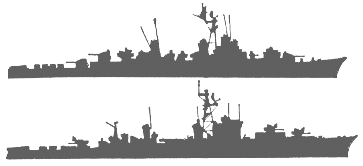
Harukaze and Ayanami compared profiles.
The Ayanami were unlike the Harukaze, which looked very much like the Japanese version of the Fletcher class (with many differences though) and looked like balanced and harmonious designs. They already tested different powerplants (pitting the Mitsubishi/Escher Weiss agains the Westinghouse models and two types of boilers) and electric welding was extensively used for their hull construction. But the engineering teams behind the new design at Mitsubishi HQ in Tokyo wanted a more tailored design and adopted very peculier solutions. The final design ended very different from the Harukaze and “properly Japanese” as it copied none other. It was also very much an “admiralty design”, a standard to be built in six different yards. Only Mitsui Zosen, Tamano built one.
The hull was very peculiar. Instead of being a flush deck with raised prow, and the same balance as a US destroyer, they had a long forecastle for better seakeeping ending 3/4 from the stern with a sloped deck, and lower deck with semi-transom stern. The Bridge and funnels looked loked they had been pushed further back. They had a lattice mast instead of a tripod, and superstructure was much reduced as most of what used to be above deck was now under deck., leaving it barebones. This was mostly for NBC making protection easier, something which was requiped to the new design in accordance to new atomic age warfare standards. The bridge was beefier than on the Harukaze, with a tall breakwater-like face and open bridge, then enclosed bridge. The fire constrol system was instaled at its back. The first ships had a short tripod mast aft, it became a larger and taller lattice mast on later batches and was rebuilt on the ealier ships for better sensors. The entire lower deck was dedicated to ASW work, with the first ships only having depht charges, but a VDS was installed in 1964-66 on three ships in class.
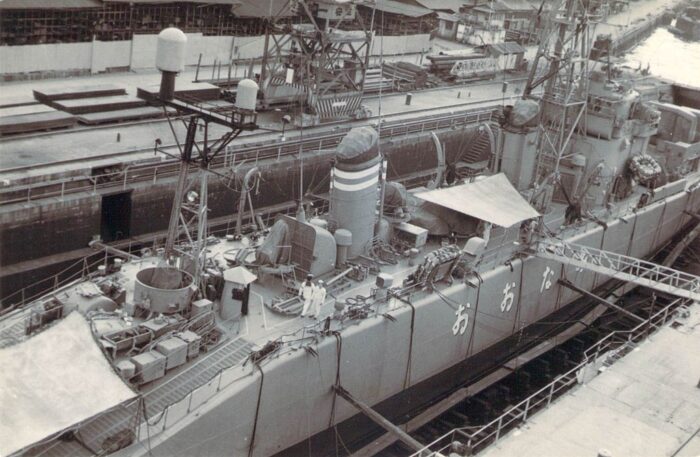
Rear section color CC photo (degraded) showing the caracteristic “Dutch slope” and funnels, and other details.
Displacement in standard was 1,720 tonnes standard (1,690 long tons) and 2,500 t (2,500 long tons) full load, which was more than the Harukaze’s 1,700/2,340t. They were also longer at 109 meters overall (358 ft) versus 106.3m overall, beamier at 10.7 m (35 ft) versus 10.5 m, and with a similar mean draft of 3.70m light (12.1 ft). Wikipedia is wrong with 8.1 m (26 ft 7 in).
Their crew amounted to 220, versus 240 on the Harukaze, thanks to a bit more automation, less personal-heavy weapons systems, which combined with a roomier hull made them appear far less cramped. They were popular with the crews and less “wet” in raining season in particular. With the NBC came also a state of the art air climatization system and a drier. It can be used to warm the interior in winter as well. The admiralty was so pleased with these ships, the follow-up class Murasame was similar in many ways (first laid down 1957).
Powerplant
This type was required to rush to areas where submarines were present as quickly as possible for anti-submarine warfare, so it was set at a maximum speed of 32 knots, which was faster than the 28DD. It was also required to maintain speed in rough seas, which was one of the reasons for adopting a long forecastle hull type. The engine was a steam turbine system like the previous Harukaze, for testing purposes, testing various types of main boilers. The Ayanami may look slender and minimalistic, they were provided with the same powerplant as for the Harukaze initially, but the admiralty wanted to test various powerplant configurations and they diverged between themselves:
-The first batch (DD103-105) was ordered with two sets of Mitsubishi/Escher-Weiss geared steam turbines like the lead ship of the previous Harukaze, coupled with two Mitsubishi/Combustion Engineering boilers.
-The next batch, DD106, 110 and 111 tested two sets of the same Mitsubishi/Escher-Weiss turbines but with two Hitachi/Babcock & Wilcox boilers.
-The last DD112 Makinami however married itw Mitsubishi/Escher-Weiss geared steam turbines with Kawasaki Jyuko BD boilers.
All these were supposed to power these ships to 35,000 hp at top speed, for a top speed of 32 kts. This was 5,000 hp more than the Harukaze for 32 knots as well. Endurance was also the same 6,000 nautical miles at 18 knots.
The boilers worked at a pressure of 30 kgf/cm2 (430 lbf/in2) and temperature of 400 °C (752 °F), but the steam generation rate was increased to 73 tons/hour for the first three (Ayanami sub-class) and for the next Uranami sub-class, but raised to 75 tons/hour for the Shikinami sub-class. The turbine type was a classic HP/LP imulse/reaction type, same as on Yukikaze, second 28DD design, found only on Isonami, but the other six ships had riple-drum impulse type turbines, albeit from the same manufacturer. Since the manually removable cruise turbine were unreliable, Ayanami was the first to adopt an automatic type. From Uranami onwards, direct drive turbines were adopted, following US Navy practice.
The engine arrangement followed the preceding Harukaze class, with the forward turbines driving the left shaft and rear one driving the right shaft, filly separate turbines and boilers, alternated. Power supply on the early batch comprises two 350 kVA (280 kW) steam turbine main generators, two 100 kVA (80 kW) diesel main generators. The latter batches had diesel main generators increased to 125 kVA (100 kW).
Armament
Early batch (DD103-106, 110, 111): 3×2 3-in/50 Mk 33, 1×4 x 533 TT (4 reloads), 2x 483mm ASW TTs, 2×24 Hedgehog Mk 15 ASWRL, 2 DCT.
DD112 alone: Same but 2×3 – 324mm TT.
This type was also the first with anti-submarine guided torpedoes, Mk.32 short-range models, plus Mk.2 533 mm launchers installed on both sides. The domestically produced Type 54 torpedo 3 prototype was also introduced for the HO-401 quad tubr launcher, with spare torpedoes on both sides of the aft funnel. The short-range torpedo launchers were later replaced with Type 68 triple short-range torpedo tubes 324 mm for Mk.44 short-range torpedoes and later licenced Type 73 or Mk.46. In addition, the conventional depth charge launchers (Y guns) and depth charge drop tracks were also installed.
3-inch/50 caliber Mk.33 guns
For the main gun, the Ayanami class were the first to adopt the new generation rapid-firing 50-caliber 7.6 cm twin gun (Mk.33 3-inch). Two were mounted at the front and one on the aft deck, for a total of three, six guns. The early model lacked a gun shield for the stern gun, but the later received a Japanese one, armoured, and later retrofitted. This gun was later produced in Japan under license, installed on 44 JMSDF ships, until those planned in 1974.
The associated gun fire control system was the Mk.63, same as for the 40 mm on the Harukaze, but the radar was now the new AN/SPG-34, installed in the No. 2 and No. 3 turrets.
Hedgehog anti-submarine mortars
The anti-submarine mortars was to be a new generation, the Weapon Alpha or British Skid initially. This was not done for budgetary reasons and in instead the improved Mk.15, using a rotating mechanism, was installed forward, at the foot of the bridge. No new generation ASW mortar was installed later.
Mark 32 triple ASW TT launchers
Installed for the first time on Japanese ships, they were standard US triple tubes, located eiother side of the bridge on platforms at the end of bulwarks.
Standard 324 mm US lightweight acoustic torpedo launchers, firing the Mark 44 torpedo.
The Underwater Attack Control System (SFCS) to control anti-submarine torpedoes was the SFCS-1A, based on the SFCS-1 developed for the Akizuki-class, but with the ballistic calculation function removed.
533 mm (21 inches) TT launchers
Unlike the previous Harukaze which had none, the Ayanamy were equipped for anti-ship (and later ASW) work, with 21-in torpedoes, likely of the Experimental Type 54 Model 3 Mod 1.
They were first used in 1954 on the Hei Guard Ships (PT Boats) and later ported on destroyers and submarines.
Designed in 1953 this was the first Japanese-designed torpedo, starting with the Type 54 Mod 1, a non-homing, straight running model developed for PT boats. An unsuccessful design which notably snk when launched it was replaced by the Mod 2 which added a surface-target acoustical homing system. First used on the Ayanami class destroyers. It was found that the torpedo body lacked strength and the homing system was unreliable. The Mod 3 improved the latter, adding a 3D type system and approximately 60 Model 3 were built. In 1966 the improved Model 3 Mod 1 was introduced and 1,500 of these were built (specs below).
Specs:
Weight; 3,230 lbs. (1,600 kg) for 299 in (7.60 m) long.
Powered by Lead-acid battery to the unique setting 6,560 yards (6,000 m) at 24 knots
Warhead 220 lbs. (100 kg) TNT.
More on navweaps
K-gun
K-Guns, depth charge throwers WW2 type likely K Guns Mark 6. capable of 60 to 150 yards (55 to 137 m) in just 3.4 to 5.1 seconds. Placed in three systems aft on deck abaft the deckhouse. The charges were 65 lbs. (29.5 kg) with increasing range, using black powder (settings 60, 90 and 150 yards (55, 82 and 137 m).
There were four systems at the poop deck aft eitehr side. They could have been provided with the later war (service 1946) Mark 16. A 435 lbs. (197 kg) model carrying a 295 lbs. (134 kg) Torpex charge with a sink Rate of 31 fps (9.4 mps) and max setting of 2,500 feet (762 m). Mod 0 was hydrostatic and Mod 1 was acoustic.
Uprades
In 1965, Ayanami and the next year, Isonami, then in 1967, Takanami were in turn equipped with the OQA-1 VDS sonar, retofitted at the stern. DC launchers and racks were deleted.
In 1976, Isonami and Shikinami saw the removal of their unique axial midship 533mm torpedo tubes bank. The space was taken by a lecture hall as the ship now acted for training.
Sensors
The early batch the AN/SPS-12 air search radar wa sinstalled, which was a lighter and improved version of the American AN/SPS-6 installed on the Harukaze class.
The later batch instead had the Japanese made OPS-1, based on these.
As for electronic warfare (EW) it was planned to equip the ships at first with the American AN/BLR-1, but due delays, early-construction ships were commissioned without this equipment, and later retroffited. They all were equipped however with the NOLR-1, also domestically produced.
The hull sonar was initially the AN/SQS-11, but the 1958 plan ships (second batch) ended instead with the AN/SQS-4.
In addition, attack sonars were installed and later the AN/SQS-31 (AN/SQS-4 mod.3 improved type) was installed as well as a variable depth sonar (VDS), later equipped with the OQA-1A (domestic version AN/SQA-10) on the Ayanami, Isonami, and Takanami from 1965-1967.
Thus the first batch, DD103-106 had the OPS-1, OPS-2, as well as SPG-34 radars and OQS-12 sonar. Built later, the bnext batch DD110 to 112 kept the OPS-1, but adopted the new OPS-5 radar, kept the SPG-34 control radars, but swapped to the new OQS-14 sonar and adopted for the first tome a BLR-1 ECM suite.
OPS-1 or AN/SPS-12
Air search radar developed as a successor to the SR-3/R-6 L Band ASR (air search radar) of WW2. Parabolic antenna using a horn antenna as primary radiation source, modular design for configuration chanegs. The antenna was 18 ft (5,500 mm) x 5 ft (1,500 mm), fpr a beamwidth of 3° x 10°, but could be detected at 80 nmi (150 km) away.
OPS-2 or AN/SQS-11
Surface-search radar, 2D, manufactured by Japan Radio Company. Installed as an anti-ship search radar for Maritime Self-Defense Force’s escort ships.
OPS-5

OPS-5 radar on Oonami.
The National Safety Agency’s Coastal Security Force obtained the AN/SPS-5B radar with the Bluebird-class minesweeper which became the Yashima-class minesweeper as part of the 1958 plan and this ledt to the development by Japan Radio of the OPS-5 installed first on JDS Akebono, Ikazuchi-class destroyer escort, then Akizuki and Ayanami class destroyer. It is a 2D radar working in C band with unlimited azimuth, power range 150 to 200 kW. It was derived into the OPS-18 in 1976.
SPG-34 Radar and AN/SQR-4/SQA-4
Working in X band at 25-30 kW with an instrumented range of 23 km and beamwidth of 2.4°, the AN/SPG-34 was developed as a fire control radar for Mk 57 gun director and Mk 63 gunfire control system, for Anti-Aircraft gunnery. It is composed of a symmetric parabolic reflector of 40 inchesn fed with a Cutler-feed.
OQS-12 (OQY-1) sonar
Coupled with the attack sonar OQY-2. It is a local copy of the AN/SQS-31 Hull Mounted Sonar (1955). No more info.
OQS-14 (OQY-1A) sonar
No data.
Active protection
BLR-1 ECM suite
Called the Radio/Radar Interception System (1951/52). No data. Antenna assemblies.
I addition they had the NOLR-1.
Acoustic torpedo
Likely T-Mk 6 Fanfare. This towed sonar decoy was developed after WW2 by the USN to replaced the Foxer noisemaker. It producedg a sound similar to its own ship propeller, rather than wideband noise and could be setup to the specific tone of each ship.

⚙ specs. |
|
| Displacement | 1,720 t (1,690 long tons) standard, 2,500 t (2,500 long tons) full load |
| Dimensions | 109 x 10.7 x 8.1m (358 x 35 x 26 ft 7 in) |
| Propulsion | 2 sets geared steam turbines, 2 boilers, 35,000 hp |
| Speed | 32 kts |
| Range | 6000 nm/18 kts |
| Armament | 6× 3″/50 Mk.22, 4× 533 mm (21 in) TTs, 2× ASW TR, 2 × Hedgehog ASWRL |
| Sensors | AN/SPS-12 ASE, OPS-5 SSR, AN/SPS-11A, OQA-1 VDS, Mark 63 FCS |
| Active Protection | NOLR-1 |
| Crew | 220 |
Career of the Ayanami class
 DD-103/ASU-7004 Ayanami
DD-103/ASU-7004 Ayanami
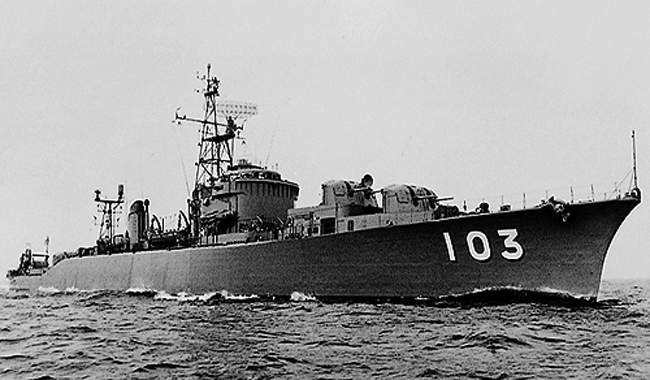
Ayanami was laid down at Mitsubishi Zosen, Nagasaki on 20 November 1956, launched on 1 June 1957 and commissioned on 12 February 1958. On March 16, she was transferred to the 8th Escort Corps, newly formed under the Yokosuka District Force, together with her sister JDS Uranami. In August she took part in second Maritime Self-Defense Force training cruise, but also the 5th cruise in 1961 and 12th long range cruise in 1968.
On October 25, 1958, the 8th Escort Corps was reorganized as the 1st Escort Corps group. On April 1, 1959, she was transferred to the 9th Escort Corps newly formed under the 1st Escort group, together with her sister JDS Uranami. She had a major overhaul modernization in 1962-1963, with new ESM and NORL-1 relocated aft, OQS-12 and attack sonar OQY-2. In July 1965, her depth charge projectors and tracks were removed to install the Variable Depth Sonar (VDS) OQA-1.
On March 15, 1969, the 9th Escort Corps became the 3rd Escort Corps group. In 1970 she lost her site short torpedo launcher but obtained two type 68 (Mark 32) triple light TTs.
On February 1, 1971, the 9th Escort Corps fell under the 4th Escort Corps, newly formed.
On October 19, 1979, she assisted the Norwegian cargo ship Berge Oder off Tokyo Bay after she was struck by a typhoon off Kisarazu, 16 km north of Futtsu Misaki. She ran aground on reefs and had a 2 meters wide, 10 meters long, 2 meters high gash at the waterline. The crew was evacuated and reached Yokosuka.
On March 30, 1983, Ayanami became a special service ship (ASU-7004), transferred to the Kure District Force, now under direct control in Kure. In addition, her amodship TT bank was removed, long torpedo launcher and VDS, and accomodations fitted. She served as such until decommissioned on Dec. 25, 1986 after 600,000 nautical miles, equivalent to 28 globe-spanning cruises.
 DD-104/TV-3502 Isonami
DD-104/TV-3502 Isonami

Isonami was laid down at Shin-Mitsubishi, Kobe on 14 December 1956, launched on 30 September 1957 and completed on 14 March 1958. On March 31, 1958, she was transferred to the Yokosuka District Force, 8th Escort Corps. On October 25, it fell under the 1st Escort Corps group. She wa soverhauled in 1962-1963 and modernized (see above). On December 24, 1964, she left Yokosuka for post-refit trials but crossed the path of the Liberia-registered tanker Olympic Grace (37,000 tons) in heavy fod and an appatent lack of watch on radar. Her rear port side was damaged by tghe feighter’s bow and she needed repairs. In March 1966, she lost two depth charge projectors and two depth charge tracks for the installation of the VDS OQA-1A.
In 1972, the short torpedo launcher was removed, and she received two Mark 32 (68-Shiki) torpedo launchers.
On June 13, 1975, the 8th Escort Squadron was disbanded and she fell under the 1st Training Squadron, transferred to Kure. In 1976, she was rebuilt as a proper training ship with the amidship torpedo launcher removed to install a trainee class. On March 30, 1983, she was reclassifed for good as training ship, TV-3502. She was decommissioned and stricken on on July 1, 1987, along with her sister ship JDS Shikinami. In 1988, she was converted as target ship at the Etajima Shipyard, sunk by anti-ship guided missiles.
 DD-105/ASU-7005 Uranami
DD-105/ASU-7005 Uranami

DD-105 Uranami was laid down at Kawasaki Shipyard, Tokyo, on 1 February 1957, launched on 29 August 1957 and commissioned on 27 February 1958. She was assigned to the JMSDF fleet in Yokosuka. On 16 March 1958 she was attached to the 8th Escort Division, then 8h Division, 1st Escort Flotilla on 25 October 1958. On 1st April 1969, she was transferred to the 9th Division, 1st Escort Flotilla, then the 9th Division, 3rd Escort Flotilla on 15 March 1969, then the 9th Division, 4th Escort Flotilla on 1 February 1971. When it was disbanded on 30 March 1983, she became the auxiliary vessel ASU-7005. She underwent also the same modernizations as her sisters in 1963-63 and 1971 and was finally decommissioned on 25 December 1986.
 DD-106/TV-3503 Shikinami
DD-106/TV-3503 Shikinami

DD-106 Shikinami was laid down at Mitsui Zosen, Tamano, on 14 December 1956, launched on 25 September 1957 and commissioned on 15 March 1958. On March 31, she was transferred to the Yokosuka District Force, 8th Escort Corps. On October 25, she fell under the 1st Escort Corps group. She was rfitted in 1963, she had her NORL-1 relocated aft and search sonar OQS-14/ attack sonar OQY-2 installed while in her March 1973 refit she lost her short torpedo launcher for two 68-type TT lighweight launchers.
On June 13, 1975, the 8th Escort Squadron was disbanded, she fell under 1st Training Squadron in Kure. In 1976, she was converted into a proper training ship with the same modifications een above. On March 30, 1983, she was registered as TV-3503. She was decommissioned on on July 1, 1987 with JDS Isonami and sold for BU in 1988, at Furusawa Steel, Etajima.
 DD-110/ASU-7009 Takanami
DD-110/ASU-7009 Takanami
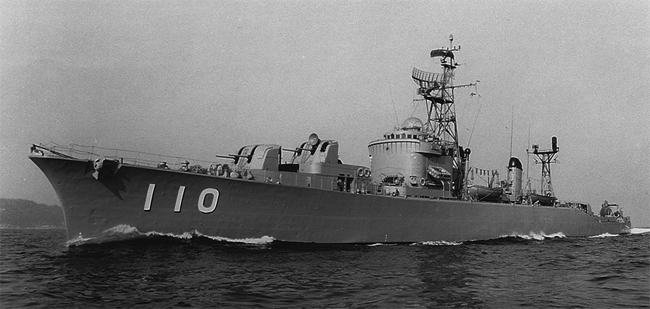
DD-110 Takanami was laid down at Mitsui Zosen, Tamano on 8 November 1958, launched on 8 August 1959 and commissioned on 30 January 1960. On 31 August she was transferred to the 11th Escort Corps, under the Kure District Force with JDS Ōnami. On 1 February 1961, it was reorganized under the Self-Defense Fleet, 2nd Escort Group. In February 1968, she received the VDS OQA-1A. On 1 February 1971, the 11th Escort Squadron fell under the 4th Escort Squadron. On 16 December 1973, she was reassigned to the 3rd Escort Corps group, transferred to Sasebo. On 1 December 1977, the 11th Escort Corps was reorganized under the Sasebo District Force and on 27 March 1985, she became the special service ship, ASU-7009, transferred to the Sasebo District Force under direct control. She was decommissioned and striken on 24 March 1989.
 D-111/ASU-7013 Ōnami
D-111/ASU-7013 Ōnami
 Ishikawajima HI, Kobe 20 D-111 Ōnami (or Oonami) was laid down in March 1959 at Mitsui Zosen, Tamano, launched on 13 February 1960, completed on 29 August 1960. On 31 August she was transferred to the 11th Escort Corps, Kure District Force with JDS Takanami. On 1 February 1961, it was reorganized under the Self-Defense Fleet, 2nd Escort Group. On 1 February 1971, it fell under the 4th Escort Squadron, escort fleet. On 16 December 1973, it fell under the 3rd Escort Corps group, Sasebo homeport. On 1 December 1977, it was reorganized again under the Sasebo District Force. In 1980, she was modernized with new Type 68 TTs (see above). On 20 February 1987, her unit was disbanded and she became the special service ship ASU-7013. She was transferred to the Sasebo District Force under direct control until decommissioned and stricken on 23 March 1990.
Ishikawajima HI, Kobe 20 D-111 Ōnami (or Oonami) was laid down in March 1959 at Mitsui Zosen, Tamano, launched on 13 February 1960, completed on 29 August 1960. On 31 August she was transferred to the 11th Escort Corps, Kure District Force with JDS Takanami. On 1 February 1961, it was reorganized under the Self-Defense Fleet, 2nd Escort Group. On 1 February 1971, it fell under the 4th Escort Squadron, escort fleet. On 16 December 1973, it fell under the 3rd Escort Corps group, Sasebo homeport. On 1 December 1977, it was reorganized again under the Sasebo District Force. In 1980, she was modernized with new Type 68 TTs (see above). On 20 February 1987, her unit was disbanded and she became the special service ship ASU-7013. She was transferred to the Sasebo District Force under direct control until decommissioned and stricken on 23 March 1990.
 DD-112/ASU-7014 Makinami
DD-112/ASU-7014 Makinami
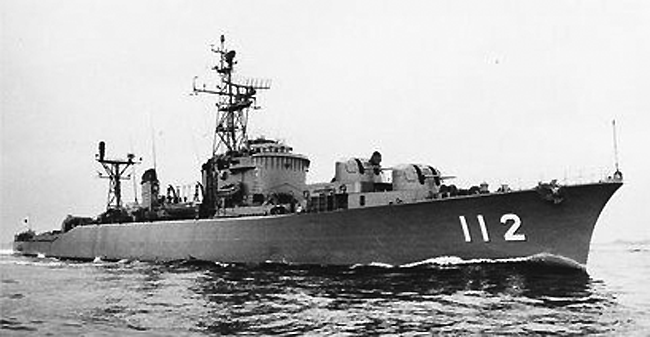
DD-112 Makinami was laid down at Iono HI, Maizuru on 20 March 1959, launched on 25 April 1960 and commissioned on 28 October 1960. She was transferred to the 11th Kure District Force. On 1 February 1961, she fell under the Self-Defense Fleet, 2nd Escort Group. On 1 February 1971, the 4th Escort Squadron, escort fleet. On 16 December 1973, under the 3rd Escort Corps group, home ported to Sasebo and modernuzed like her sisters. On 1 December 1977, her unit was reorganized under the Sasebo District Force. On 20 February 1987, it was disbanded and she became like her sisters a special service ship, ASU-7014. She was transferred to the Sasebo District Force under direct control under decommissioned on 23 March 1990.
Read More/Src
Books
World Ships Special Edition 66th Collection Maritime Self-Defense Force All Ship History. Gaijinsha. 2004.
World Ships Special Edition 63rd Vol. 12 Ships that Colored the History of Self Defense Ships. Gaijinsha. 2003.
Takao, Ishibashi (2002). All Maritime Self-Defense Force Ships 1952-2002. Namiki Shobo.
History of Japanese destroyers since 1952″. Ships of the World (in Japanese) (742).
“1. Hull (Hardware of JMSDF destroyers)”. Ships of the World (in Japanese) (742). Kaijin-sha: 100–105. June 2011.
Yasuo Abe (June 2011). “2. Propulsion system (Hardware of JMSDF destroyers)”. Ships of the World (in Japanese) (742).
“3. Underwater weapons (Shipboard weapons of JMSDF 1952-2010)”. Ships of the World (721). Kaijin-sha: 94–99. March 2010.
“2. Guns (Shipboard weapons of JMSDF 1952-2010)”. Ships of the World (721). Kaijin-sha: 88–93. March 2010.
Gardiner and Chumbley 1995, p. 223.
Gardiner, Robert; Chumbley, Stephen (1995). Conway’s All The World’s Fighting Ships 1947–1995. Annapolis, Maryland, USA: Naval Institute Press. ISBN 1-55750-132-7.
Kaijinsha, ed., “Japan’s Destroyers (Postwar Edition),” Ships of the World, no. 742, Kaijinsha, pp. 91-135, June 2011.
Abe, Yasuo, “The Progress of Maritime Self-Defense Force Escort Ship Development. no. 571, Kaijinsha, July 2000.
Abe, Yasuo, “Technical Features of Escort Ships – 2. Propulsion Systems,” Ships of the World, no. 742 Kaijinsha. June 2011.
Otsuka Yoshifuru, “Technical Features of the JMSDF General-Purpose Escort Ship,” Ships of the World, No. 997, Kaijinsha July 2023.
Koda Yoji, “The Progress of Domestic Escort Ship Construction,” Ships of the World, No. 827, Kaijinsha, December 2015.
Sakata Hideo, “The Progress of the JMSDF FCS,” Ships of the World, No. 493, Kaijinsha, pp. 70-75, March 1995.
Sekigawa Takeshi, “Evolution of Underwater Attack Control Systems,” Volume 4, Torpedoes, Suikokai, “The JMSDF’s Painstaking Footprints,” 2013,
Tomohiko Tada, “4. Radar/Electronic Warfare Equipment (MSDF Shipboard Weapons 1952-2010),” No. 721, Kaijinsha, pp. 100-105, March 2010.
Eiichi Yoshihara, “Hull (History of MSDF Escort Ships 1953-2000) — (Technical Features of MSDF Escort Ships),” No. 571, Kaijinsha July 2000
Links
on ja.wikipedia.org
en.wikipedia.org/
on commons.wikimedia.org/
web.archive.org navypedia.org/
radartutorial.eu
Model Kits
on scalemates.com/: pit-road, Model Factory Kyu-Kyu Shiki 1:700 only.
See also this 1:900 miniature



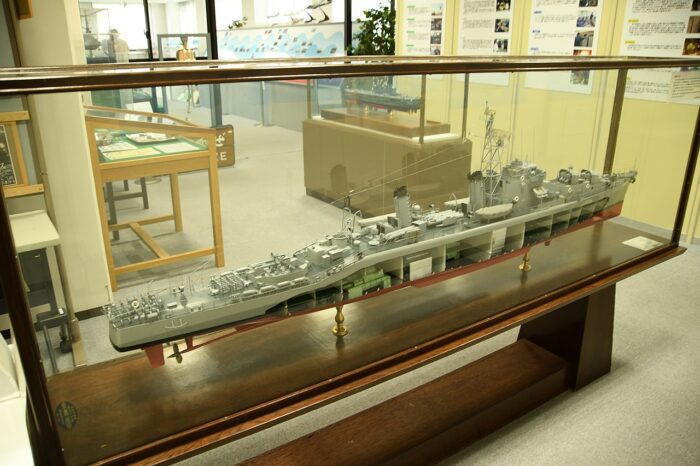
 Latest Facebook Entry -
Latest Facebook Entry -  X(Tweeter) Naval Encyclopedia's deck archive
X(Tweeter) Naval Encyclopedia's deck archive Instagram (@navalencyc)
Instagram (@navalencyc)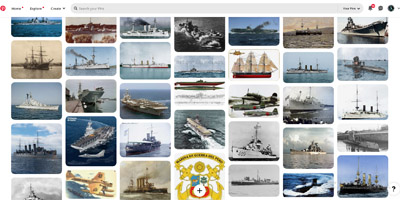

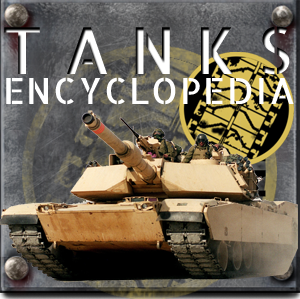
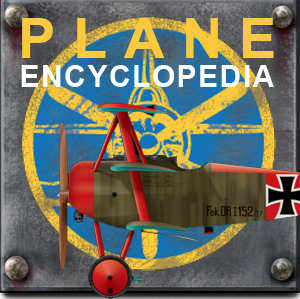
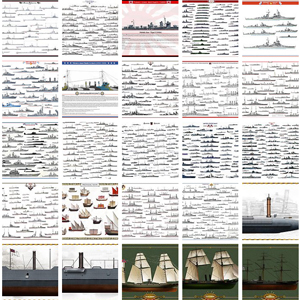
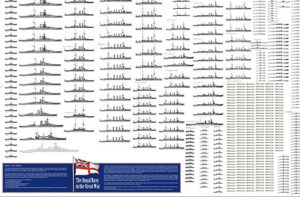
 French Navy
French Navy Royal Navy
Royal Navy Russian Navy
Russian Navy Armada Espanola
Armada Espanola Austrian Navy
Austrian Navy K.u.K. Kriegsmarine
K.u.K. Kriegsmarine Dansk Marine
Dansk Marine Nautiko Hellenon
Nautiko Hellenon Koninklije Marine 1870
Koninklije Marine 1870 Marinha do Brasil
Marinha do Brasil Osmanlı Donanması
Osmanlı Donanması Marina Do Peru
Marina Do Peru Marinha do Portugal
Marinha do Portugal Regia Marina 1870
Regia Marina 1870 Nihhon Kaigun 1870
Nihhon Kaigun 1870 Preußische Marine 1870
Preußische Marine 1870 Russkiy Flot 1870
Russkiy Flot 1870 Svenska marinen
Svenska marinen Søværnet
Søværnet Union Navy
Union Navy Confederate Navy
Confederate Navy Armada de Argentina
Armada de Argentina Imperial Chinese Navy
Imperial Chinese Navy Marinha do Portugal
Marinha do Portugal Mexico
Mexico Kaiserliche Marine
Kaiserliche Marine 1898 US Navy
1898 US Navy Sovietskiy Flot
Sovietskiy Flot Royal Canadian Navy
Royal Canadian Navy Royal Australian Navy
Royal Australian Navy RNZN Fleet
RNZN Fleet Chinese Navy 1937
Chinese Navy 1937 Kriegsmarine
Kriegsmarine Chilean Navy
Chilean Navy Danish Navy
Danish Navy Finnish Navy
Finnish Navy Hellenic Navy
Hellenic Navy Polish Navy
Polish Navy Romanian Navy
Romanian Navy Turkish Navy
Turkish Navy Royal Yugoslav Navy
Royal Yugoslav Navy Royal Thai Navy
Royal Thai Navy Minor Navies
Minor Navies Albania
Albania Austria
Austria Belgium
Belgium Columbia
Columbia Costa Rica
Costa Rica Cuba
Cuba Czechoslovakia
Czechoslovakia Dominican Republic
Dominican Republic Haiti
Haiti Hungary
Hungary Honduras
Honduras Estonia
Estonia Iceland
Iceland Eire
Eire Equador
Equador Iran
Iran Iraq
Iraq Latvia
Latvia Liberia
Liberia Lithuania
Lithuania Mandchukuo
Mandchukuo Morocco
Morocco Nicaragua
Nicaragua Persia
Persia San Salvador
San Salvador Sarawak
Sarawak Uruguay
Uruguay Venezuela
Venezuela Zanzibar
Zanzibar Warsaw Pact Navies
Warsaw Pact Navies Bulgaria
Bulgaria Hungary
Hungary

 Bundesmarine
Bundesmarine Dutch Navy
Dutch Navy Hellenic Navy
Hellenic Navy Marina Militare
Marina Militare Yugoslav Navy
Yugoslav Navy Chinese Navy
Chinese Navy Indian Navy
Indian Navy Indonesian Navy
Indonesian Navy JMSDF
JMSDF North Korean Navy
North Korean Navy Pakistani Navy
Pakistani Navy Philippines Navy
Philippines Navy ROKN
ROKN Rep. of Singapore Navy
Rep. of Singapore Navy Taiwanese Navy
Taiwanese Navy IDF Navy
IDF Navy Saudi Navy
Saudi Navy Royal New Zealand Navy
Royal New Zealand Navy Egyptian Navy
Egyptian Navy South African Navy
South African Navy






























 Ukrainian Navy
Ukrainian Navy dbodesign
dbodesign